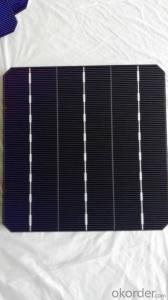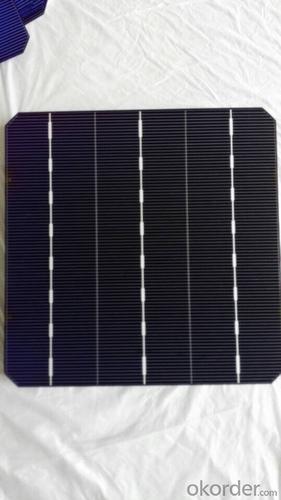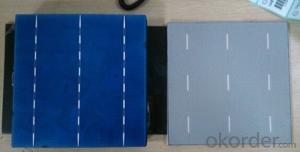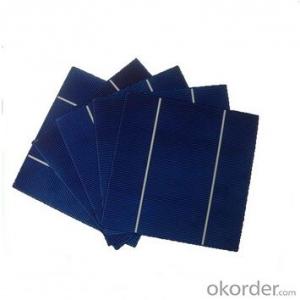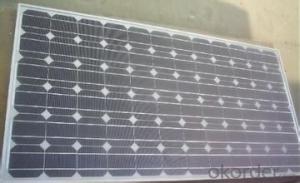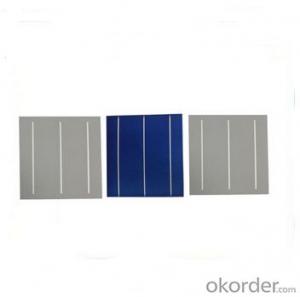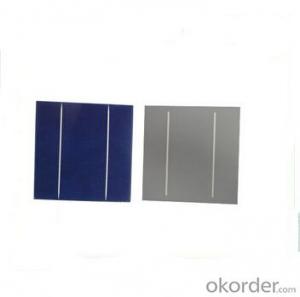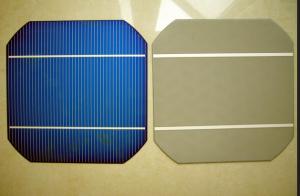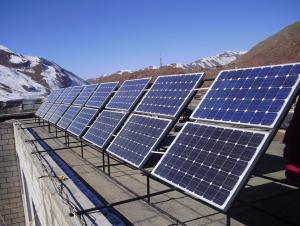Polycrystalline Solar Cells 156*156
- Loading Port:
- China Main Port
- Payment Terms:
- TT or LC
- Min Order Qty:
- -
- Supply Capability:
- -
OKorder Service Pledge
OKorder Financial Service
You Might Also Like
Mono Solar Cell 156mm Details:
| Minimum Order Quantity: | 4000w | Unit: | watt | Loading Port: | SHENZHENPort |
| Supply Ability: | 1GW Per Year | Payment Terms: | TT OR LC |
Product Description:
Details Of Mono Solar Cell 156mm
Specifications Of Mono Solar Cell 156mm
1.Mechanical data and design
Format | 156 mm × 156 mm ± 0.5 mm |
Thickness | - 210 μm ± 40 μm |
Front(-) | 1.5 mm bus bars (silver),blue anti-reflection coating (silicon nitride) |
Back (+) | 2.5 mm wide soldering pads (silver) back surface field (aluminium) |
2.Temperature Coefficient of Cells
Voc. Temp . coef.%/K | -0.35%/K |
Isc . Temp . coef.%/K | +0.024%/K |
Pm. Temp. coef.%/K | -0.47%/K |
3.Electrical Characteristic
Efficiency (%) | Pmpp (W) | Umpp (V) | Impp (A) | Uoc (V) | Isc (A) | FF (%) |
18.35 | 4.384 | 0.526 | 8.333 | 0.63 | 8.877 | 78.3% |
18.20 | 4.349 | 0.526 | 8.263 | 0.63 | 8.789 | 78.54% |
18.05 | 4.313 | 0.525 | 8.216 | 0.63 | 8.741 | 78.32% |
17.90 | 4.277 | 0.524 | 8.161 | 0.629 | 8.713 | 78.04% |
17.75 | 4.241 | 0.523 | 8.116 | 0.629 | 8.678 | 77.70% |
17.60 | 4.206 | 0.521 | 8.073 | 0.628 | 8.657 | 77.36% |
17.45 | 4.170 | 0.519 | 8.039 | 0.628 | 8.633 | 76.92% |
17.30 | 4.134 | 0.517 | 8.004 | 0.626 | 8.622 | 76.59% |
17.15 | 4.098 | 0.516 | 7.938 | 0.625 | 8.537 | 76.80% |
17.00 | 4.062 | 0.512 | 7.933 | 0.625 | 8.531 | 76.18% |
16.75 | 4.002 | 0.511 | 7.828 | 0.625 | 8.499 | 75.34% |
16.50 | 3.943 | 0.510 | 7.828 | 0.625 | 8.484 | 74.36% |
4.Intensity Dependence
Intensity [W/m2] | Isc× [mA] | Voc× [mV] |
1000 | 1.00 | 1.000 |
900 | 0.90 | 0.989 |
500 | 0.50 | 0.963 |
300 | 0.30 | 0.939 |
200 | 0.20 | 0.920 |
Advantage Of Mono Solar Cell 156mm
1: high quality cell, Level A cell
2: Dimensione:125*125mm Diagonal:150mm / 165mm
Dimensione:156*156mm Diagonal:200mm
3: Qualified certification: TUV,CE certification.
4: Warranty: five years for whole unit
Usage/Application Of Mono Solar Cell 156mm
Monocrystalline solar cells are currently the fastest developing a solar cell, its structure and production process has been finalized, the products have been widely used for space and ground. Such solar cells with high purity silicon rods as raw materials. Silicon rods, material performance indicators in order to reduce production costs, and now solar terrestrial applications such as the use of solar grade somewhat relaxed. Some semiconductor devices can also be used for processing materials and discard the head and tail of silicon materials, solar cells after re-drawn into a dedicated silicon rods.
Packaging & Delivery Of Mono Solar Cell 156mm | |
Packaging Detai | Packaging Detail:Export Carton and Pallet or under customer request. |
Delivery Detail:10-20days | |
- Q: Can solar cells be used in remote or inaccessible locations?
- Yes, solar cells can be used in remote or inaccessible locations. Solar panels can be installed in such areas to generate electricity from sunlight, eliminating the need for a traditional power grid connection. This makes solar energy a viable and sustainable option for providing electricity to places that are difficult to reach or far away from existing infrastructure.
- Q: Can solar cells be used in theme parks or amusement parks?
- Yes, solar cells can definitely be used in theme parks or amusement parks. Solar cells can be installed on rooftops, parking lots, and other open spaces within these parks to generate clean and renewable energy. This energy can be utilized to power rides, lighting systems, water features, and other facilities within the park, reducing reliance on traditional power sources and lowering carbon emissions. Moreover, solar panels can also serve as educational tools, allowing park visitors to learn about renewable energy and sustainability.
- Q: Can solar cells be used for indoor applications?
- Yes, solar cells can be used for indoor applications. However, their efficiency is significantly reduced compared to outdoor use due to limited access to direct sunlight. Indoor solar cells can still generate electricity from artificial light sources, but they are typically less productive and may require additional lighting to optimize their performance.
- Q: Can solar cells be used in military applications?
- Yes, solar cells can be used in military applications. They have various applications in the military, including powering remote surveillance systems, communication equipment, and providing electricity to field operations in remote areas. Solar cells offer a reliable and sustainable source of energy, reducing the reliance on traditional fuel sources and enhancing the operational efficiency of military units. Additionally, solar technology can be integrated into portable and lightweight systems, improving mobility and reducing the logistical burden for military personnel.
- Q: Solar panel resistance is changed with what
- To be sure that this question is very professional. Secondly, I have to answer this question: the internal resistance of solar energy, mainly reflected in the power generation, the inhibition of current. In the time of power generation,
- Q: How do solar cells perform in different temperature ranges?
- Solar cells generally perform better in cooler temperatures. As the temperature increases, the efficiency of solar cells tends to decrease. However, the actual performance can vary depending on the specific type of solar cell and its design.
- Q: What is the best way to deal with surplus solar cells abandoned after burning?
- It has to be treated in a special way, which is chemically separated, otherwise, the surplus can not really be utilized again.
- Q: What is the environmental impact of manufacturing solar cells?
- The manufacturing of solar cells has both positive and negative environmental impacts. On the positive side, solar cells generate clean and renewable energy, reducing the reliance on fossil fuels and thereby decreasing greenhouse gas emissions and air pollution. Additionally, solar cells have a long lifespan and require minimal maintenance, reducing the overall environmental impact compared to other energy sources. However, the production process of solar cells does have some negative environmental consequences. The extraction of raw materials, such as silicon and rare earth metals, can lead to habitat destruction, water pollution, and soil degradation. The manufacturing process also requires energy and water, which can contribute to carbon emissions and water scarcity if not managed efficiently. Overall, while the production of solar cells does have some environmental impacts, it is important to consider them in relation to the significant environmental benefits that solar energy provides in terms of reducing carbon emissions and mitigating climate change.
- Q: How does solar cell technology apply to our daily life?
- The solar cell which can format the solar array generates solar power for daily life usage.
- Q: Can solar cells be used in parking lots?
- Yes, solar cells can certainly be used in parking lots. Solar panels can be installed on carports or overhead structures in parking lots to capture solar energy and convert it into electricity. This can help provide power to the lighting systems, electric vehicle charging stations, and other electrical needs in the parking lot, while also reducing the reliance on traditional grid electricity and decreasing carbon emissions.
Send your message to us
Polycrystalline Solar Cells 156*156
- Loading Port:
- China Main Port
- Payment Terms:
- TT or LC
- Min Order Qty:
- -
- Supply Capability:
- -
OKorder Service Pledge
OKorder Financial Service
Similar products
Hot products
Hot Searches
Related keywords
